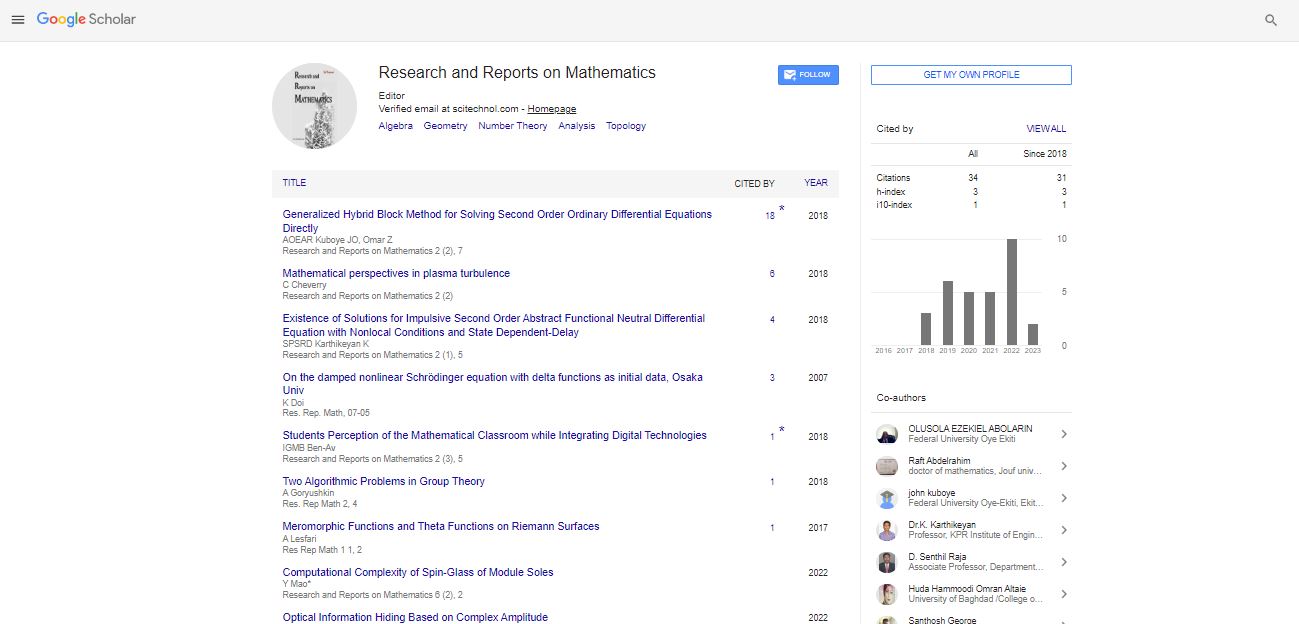Short Communication, Res Rep Math Vol: 4 Issue: 1
Bounded Energy on Compressible Fluid Dynamics and Plasma Physics with Air/Gas Flow
Tim Tarver*
Department of Mathematics, Bethune-Cookman University, USA
*Corresponding Author : Tim Tarver
Professor, Department of Mathematics, Bethune-Cookman University, USA
Tel: +386-481-2000
E-mail: ttarver31@gmail.com
Received: March 27, 2018 Accepted: August 04, 2018 Published: October 11, 2018
Citation: Tarver T (2018) Bounded Energy on Compressible Fluid Dynamics and Plasma Physics with Air/Gas Flow. Res Rep Math 2:3.
Abstract
Let (x, t) and p(x, t) be a velocity vector and pressure illustrated on some fluid. Then, there exists new concepts possibly applicable to various fields. These new ideas will be presented as derivation from previously developed mathematical concepts. The new rules are Partial Integrating Factors, Partial Integration by Parts and Partial Integration with Exponentials. The goal of this paper is to define a velocity vector field over some liquid or gas.
Keywords: Velocity vector; Partial Integratio; Exponentials
Introduction
There are problems in the field of fluid dynamics displaying difficulty to analyze fluid flow. Scientists are in the process of conceptualizing fluid flow beginning with streamlines. The goal was to generate new concepts creating some defined velocity vector  and associated pressure p(x, t). According to McDonough et al. [1], a streamline is defined as a continuous line within fluids where the tangent plane at each point is the direction of some velocity vector at that point. The kicker is a velocity vector on a fluid was unknown for some time until just recently.
and associated pressure p(x, t). According to McDonough et al. [1], a streamline is defined as a continuous line within fluids where the tangent plane at each point is the direction of some velocity vector at that point. The kicker is a velocity vector on a fluid was unknown for some time until just recently.
Body
These new ideas can possibly be used in the field of Computational Fluid Dynamics to analyze flow. The word turbulent implies unsteady fluid flow with respect to time. Contrarily, steady flow without time. The new definitions can be applied to hydrodynamics; the study of liquid flow. The flow of gases is said to have favoring characteristics as fluid flow with existing differences. If the density is unchangeable through a fluid flow field, then the fluid is incompressible. If the density of fluid flow does change, it is compressible [2]. The difference between fluids and gas come in on the natural forces being applied to liquids instead of gases.
Air, gas and fluid flow can be laminar or turbulent [3]. Laminar flow is defined as a smooth, motion of fluid where there exist deviations caused by some force [4]. The definition implies a smooth, divergence free velocity vector field  with applied pressure over a streamline of liquid. Recall and note C∞ to be the set of infinite partial derivatives
with applied pressure over a streamline of liquid. Recall and note C∞ to be the set of infinite partial derivatives  with respect to x ∈ 3, showing the fluid’s incompressibility and existing bounded energy, ∀t>0.
with respect to x ∈ 3, showing the fluid’s incompressibility and existing bounded energy, ∀t>0.
Bounded energy
Let (x, t) be equal to
(x, t) be equal to
Then, we should find its bounded energy by finding the absolute value of vector  squared. For example, let the velocity begin at point A (1,2). We want to determine the bounded energy of the velocity vector after it stops at point B (4,6). Next, we take the absolute value of the given vector squared to calculate the bounded energy on 3. Thus, by partial integration with exponentials we obtain
squared. For example, let the velocity begin at point A (1,2). We want to determine the bounded energy of the velocity vector after it stops at point B (4,6). Next, we take the absolute value of the given vector squared to calculate the bounded energy on 3. Thus, by partial integration with exponentials we obtain

For all t strictly greater than 0 and is a subset in the differentiability class, C∞.
Streamline displacement velocity
The bounded energy can be calculated as streamline displacement velocity from point A to B. The calculations of this concept are as follows,

Conclusion
Thus, the displacement velocity of the given streamline vector is

References
- McDonough JM (2009) Lectures in Elementary Fluid Dynamics: Physics, Mathematics and Applications. University of Kentucky, Kentucky, USA.
- Balachandran P (2006) Fundamentals of Compressible Fluid Dynamics. PHI Learning, Delhi, India.
- Lucas J (2014) What is Fluid Dynamics? Live Science, Purch Group, Utah, USA.
- McMurtry P (2000) Observations About Turbulent Flows. University of Utah, Utah, USA.
 Spanish
Spanish  Chinese
Chinese  Russian
Russian  German
German  French
French  Japanese
Japanese  Portuguese
Portuguese  Hindi
Hindi 